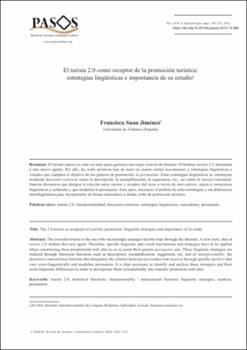El turista 2.0 como receptor de la promoción turística: estrategias lingüísticas e importancia de su estudio
Author
Suau Jiménez, FranciscaDate
2012Abstract
El turista/viajero es cada vez más quien gestiona sus viajes a través de Internet. El término turista 2.0, denomina a este nuevo agente. Por ello, las webs turísticas han de tener en cuenta ciertos mecanismos y estrategias lingüísticas y
visuales que cumplan el objetivo de los géneros de promoción: la persuasión. Estas estrategias lingüísticas se construyen mediante funciones retóricas como la descripción, la ejemplifi cación, la sugerencia, etc., así como la interpersonalidad,
función discursiva que designa la relación entre emisor y receptor del texto a través de marcadores, sujeta a variaciones lingüísticas y culturales y que modaliza la persuasión. Será, pues, necesario el análisis de estas estrategias y sus diferencias interlingüísticas para incorporarlas de forma sistemática a dichas webs de promoción turística. The traveller/tourist is the one who increasingly manages her/his trips through the Internet. A new term, that of
tourist 2.0, defi nes this new agent. Therefore, specifi c linguistic and visual mechanisms and strategies have to be applied
when constructing these promotional web sites so as to assist their generic persuasive aim. These linguistic strategies are
realized through rhetorical functions such as description, exemplifi cation, suggestion, etc. and of interpersonality, the
discursive interactional function that designates the relation between text sender and receiver through specifi c markers that
vary cross-linguistically and modulate persuasion. It is then necessary to identify and analyze these strategies and their
cross-linguistic differences in order to incorporate them systematically into touristic promotion web sites.





